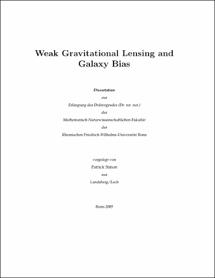Weak Gravitational Lensing and Galaxy Bias

Weak Gravitational Lensing and Galaxy Bias

| dc.contributor.advisor | Schneider, Peter | |
| dc.contributor.author | Simon, Patrick | |
| dc.date.accessioned | 2020-04-07T23:31:55Z | |
| dc.date.available | 2020-04-07T23:31:55Z | |
| dc.date.issued | 2005 | |
| dc.identifier.uri | https://hdl.handle.net/20.500.11811/2281 | |
| dc.description.abstract | Galaxies were formed from primordial baryonic matter within the gravitational potential of the dark matter. Today a confusing wealth of different galaxy populations is known. Explaining the emergence of this zoo of galaxy types is one of the hot topics of modern cosmology. The statistical relation between the galaxy and dark matter distribution is commonly summarised by the so-called bias parameters. The dependence of these parameters on galaxy population, redshift and scale will add new pieces to the puzzle of galaxy formation and evolution. Weak gravitational lensing opens up a new window of opportunity to probe the galaxy bias as a function of redshift and (even non-linear) scale. The following gives a broad overview of the thesis: - Chapter 1 sets the framework for describing cosmic structure formation. In particular, it introduces statistical quantities that are commonly employed to quantify clustering and galaxy bias. Another aim of the chapter is to outline the definitions of the key quantities in weak gravitational lensing. - Chapter 2 derives a phenomenological model for the evolution of galaxy bias on large scales. The important bottom line of this model is that the evolution of galaxy bias is sensitive to the details of the physical process that locally adds galaxies to, or removes galaxies from, a population of galaxies. -The aperture statistics incorporating weak gravitational lensing, that can be used to measure the galaxy bias from contemporary wide-field galaxy surveys, are explained and discussed in Chapter 3. The main effort is to draw a comparison between two practical estimators of the aperture statistics on the basis of simulated weak lensing surveys. Under realistic circumstances both estimators yield clearly different results. Only the most reliable estimator is used in the remainder of the thesis. - In Chapter 4, the aperture statistics are applied to the Garching-Bonn Deep Survey (GaBoDS). Using these data the dark matter-galaxy bias is measured for a range of scales and three typical redshifts. The galaxy samples are found to be differently clustered with respect to the dark matter. Various practical aspects of the technique are discussed here. The survey does not allow, however, to select galaxies from a narrow redshift range or to distinguish between different types of galaxies because only the apparent brightnesses of galaxies in one filter band are available. Such a selection would be required to investigate galaxy bias as a function of redshift and galaxy type. - The data of COMBO-17 do not have these limits, but is, however, limited by the relatively small survey area. It is analysed with focus on galaxy bias in Chapter 5. The aperture statistics is used there to measure the dark matter-galaxy bias for early-type and late-type, broadly selected by colour, galaxies belonging to four distinct narrow redshift bins. Moreover, the aperture statistics is extended so that it can also be employed to measure the relative bias between the two galaxy populations. By applying this extension it is shown that the spatial distributions of both populations are significantly different. An evolution of galaxy bias with redshift larger than the statistical uncertainties of the measurement is not found. -Leaving the topic of galaxy bias, Chapter 6 studies how constraints on the redshifts of source galaxies improve the confidence on cosmological parameters derived from second-order cosmic shear correlations. A new method is introduced, based on the recipe for Monte Carlo simulation in Chapter 3, to estimate the covariances of the statistical errors in measured cosmic shear correlations. | en |
| dc.language.iso | eng | |
| dc.rights | In Copyright | |
| dc.rights.uri | http://rightsstatements.org/vocab/InC/1.0/ | |
| dc.subject | Galaxien | |
| dc.subject | Entwicklung | |
| dc.subject | Statistik | |
| dc.subject | Bias | |
| dc.subject | räumliche Verteilung | |
| dc.subject | Galaxiendurchmusterung | |
| dc.subject | Garching-Bonn Deep Survey | |
| dc.subject | COMBO-17 | |
| dc.subject | Kosmologie | |
| dc.subject | Theorie | |
| dc.subject | Dunkle Materie | |
| dc.subject | Einschränkung kosmologischer Parameter | |
| dc.subject | Kosmische Scherung | |
| dc.subject | Großräumige Struktur des Kosmos | |
| dc.subject | Theorie | |
| dc.subject | Schwacher Gravitationslinseneffekt | |
| dc.subject | Numerische Methoden | |
| dc.subject | galaxies | |
| dc.subject | evolution | |
| dc.subject | statistics | |
| dc.subject | clustering | |
| dc.subject | wide-field galaxy survey | |
| dc.subject | cosmology | |
| dc.subject | theory | |
| dc.subject | dark matter | |
| dc.subject | contraints on cosmological parameters | |
| dc.subject | cosmic shear | |
| dc.subject | large-scale structure of Universe | |
| dc.subject | theory | |
| dc.subject | weak gravitational lensing | |
| dc.subject | numerical methods | |
| dc.subject.ddc | 520 Astronomie, Kartografie | |
| dc.subject.ddc | 530 Physik | |
| dc.title | Weak Gravitational Lensing and Galaxy Bias | |
| dc.type | Dissertation oder Habilitation | |
| dc.publisher.name | Universitäts- und Landesbibliothek Bonn | |
| dc.publisher.location | Bonn | |
| dc.rights.accessRights | openAccess | |
| dc.identifier.urn | https://nbn-resolving.org/urn:nbn:de:hbz:5N-05487 | |
| ulbbn.pubtype | Erstveröffentlichung | |
| ulbbnediss.affiliation.name | Rheinische Friedrich-Wilhelms-Universität Bonn | |
| ulbbnediss.affiliation.location | Bonn | |
| ulbbnediss.thesis.level | Dissertation | |
| ulbbnediss.dissID | 548 | |
| ulbbnediss.date.accepted | 16.06.2005 | |
| ulbbnediss.fakultaet | Mathematisch-Naturwissenschaftliche Fakultät | |
| dc.contributor.coReferee | Kroupa, Pavel |
Files in this item
This item appears in the following Collection(s)
-
E-Dissertationen (4369)




